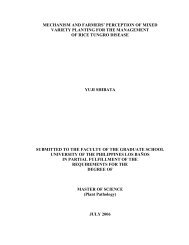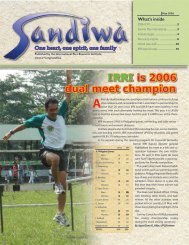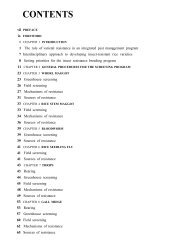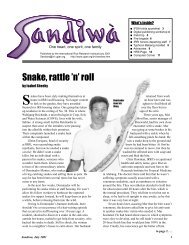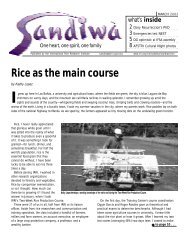Untitled - International Rice Research Institute
Untitled - International Rice Research Institute
Untitled - International Rice Research Institute
Create successful ePaper yourself
Turn your PDF publications into a flip-book with our unique Google optimized e-Paper software.
Pinatubo oryzae Manandhar & Mew<br />
Disease caused: seed rot<br />
a. Symptoms<br />
Gray lesions on plumules.<br />
b. Occurrence/distribution<br />
Pinatubo oryzae is frequently encountered in rice<br />
seed grown in the Philippines and other countries<br />
occurring on both germinated and nongerminating<br />
seeds (Fig. 56).<br />
c. Disease history<br />
This fungus was previously identified as Verticillium<br />
cinnabarinum and re-identified as Pinatubo<br />
oryzae in 1996. It has been detected from rice<br />
seeds since 1982. It is highly probable that the<br />
organism was already present earlier but there are<br />
no literatures to document any efforts to identify<br />
the fungus.<br />
d. Importance in crop production<br />
This fungus is a rice grain pathogen. It is minor in<br />
importance to rice production.<br />
→<br />
Detection on seed<br />
a. Incubation period on blotter<br />
Using the blotter test, P. oryzae can be observed<br />
on rice seeds 5 d after incubation in NUV light at<br />
21 °C. The detection frequency is about 25.2% on<br />
rice seeds coming from different regions.<br />
b. Habit character<br />
Aerial mycelia are sparse to abundant and white<br />
with loose and abundant branching. Conidia are<br />
borne terminally and arranged in a flower-like<br />
manner. Pionnotes present on the seed surface<br />
are wet and creamy to pink or they hang under a<br />
thin cover of aerial hyphae (Fig. 57 a-c).<br />
c. Location on seed<br />
P. oryzae is most often observed over the entire<br />
seed surface (about 46%) (Fig. 58).<br />
Microscopic character<br />
a. Mycelia—hyaline, septate (Fig. 57d).<br />
b. Conidiophore—simple or branched, short, septate<br />
with denticles at the terminal portion (Fig. 57e).<br />
c. Conidia—elongately oval, single- to 2-celled,<br />
very rarely 3-celled; pointed at the basal portion<br />
and rounded at the apical portion, hyaline (Fig.<br />
57f). Measurements: 5.06–10.81 µ × 2.70–6.21 µ<br />
(PDA); 5.75–12.88 µ × 2.76–5.98 µ (PSA); and<br />
5.75–11.73 µ × 2.53–5.06 µ (MEA).<br />
Colony characters on culture media (Fig. 59)<br />
Colonies on PDA at ART (28–30 °C) grow relatively<br />
fast and attain a 5.02-cm diam in 5 d. They are zonated<br />
with even margins, floccose, and reddish or-<br />
Fig. 56. Occurrence of Pinatubo oryzae on rice seed from different countries received at IRRI (IRRI-SHU unpublished<br />
data 1990-97).<br />
51



